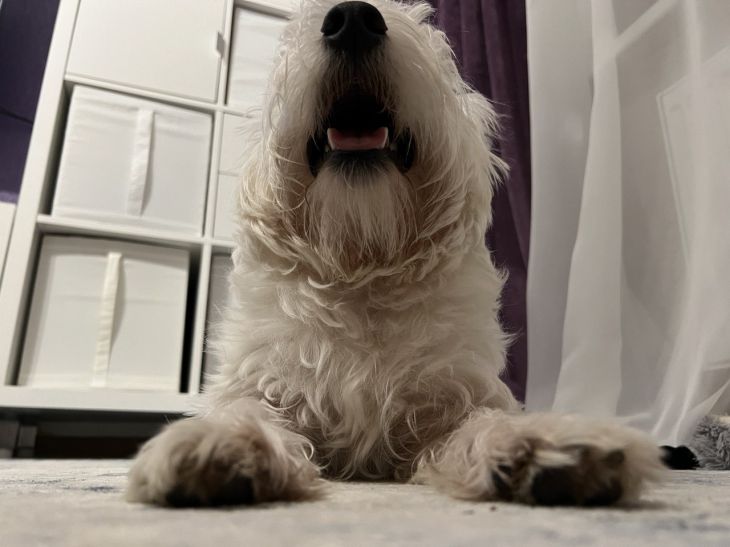Why Dogs Don't Like Their Paws Touched: 10 Reasons
Many dog owners notice that their pets do not like it when someone touches their paws.
This can cause discomfort or even stress to the dog. In this article, we will try to understand the reasons for this behavior.
Sensitivity
Dogs have many nerve endings in their paws, and certain areas may be more sensitive than others.
Some may be uncomfortable or painful when their paws are touched due to skin irritation, allergies, or medical conditions.
If your dog shows signs of paw sensitivity, such as pulling away, licking, or biting his paws, consult your veterinarian to rule out any underlying health issues.

Start by associating positive experiences with handling the paw. Offer a treat or praise your dog whenever you gently touch its paws.
Gradually increase the duration and intensity of paw work over several training sessions.
If your dog shows signs of discomfort or stress, return to the level he was comfortable at.
Past negative experiences
If your pet has had a bad experience with their paws, such as getting injured or experiencing pain while having their nails trimmed, they may develop a fear or anxiety about having their paws touched.
Keep this in mind and be patient and understanding when working with a dog that has had a negative experience in the past.
Build trust and create positive associations using counter-conditioning techniques.
Gradually teach your dog to be gentle with his paws, while offering treats and praise.
Start with short, non-threatening touches and gradually increase the duration and intensity as your dog becomes more comfortable.
Take your time and be patient. It may take time for your dog to overcome fear or anxiety.
Lack of socialization
Dogs that have not been properly accustomed to various types of handling, such as paw touching, may find it strange or frightening later in life. Socialization is crucial to helping dogs become comfortable with handling.
Gradually, from an early age, introduce your dog to different types of touch, including stroking his paws. Make it a positive experience by using treats, praise, and rewards during your dog's work sessions.
Introduce your pet to a variety of people, including children, so that he gets used to different handling styles and can develop positive associations with them.
Fear of limitations
Dogs may associate paw handling with being restrained, such as during nail trims or veterinary exams, leading to a negative perception of having their paws touched at all.
If your dog is afraid, it is important to gain its trust and create positive associations with handling your paw.
Start by getting your dog used to being restrained. Gradually accustom him to having his paws touched, while providing comfort and safety.
Use positive reinforcement techniques such as treats and rewards to create positive associations with handling the paw. Break the process into small steps, rewarding the dog after each subsequent step.
Lack of trust
Dogs are very sensitive to their owner's emotions and body language. If a pet does not fully trust a person or feels insecure, they may be less comfortable when their paws are touched.
Building trust and creating strong bonds is critical to helping your dog feel more comfortable.
Focus on strengthening your bond with your dog through positive interactions, games, and exercise. Practice regular positive reinforcement training to build trust and improve communication with your dog.
Don't force the process, let the dog move at its own pace and offer a treat.
Ticklish
Like people, some dogs may be ticklish, and having their paws touched may cause discomfort. Some dogs may withdraw their paws or signal discomfort by barking.
When touching your dog's paws, pay attention to his reactions and body language. Respect his sensitivity and avoid over-tickling or over-stimulating him. Focus on gradual desensitization and positive reinforcement to help your dog become more tolerant of paw handling over time.
Experiment with different techniques, such as a firmer touch or gentle pressure, to find what feels most comfortable.
Natural instincts
Dogs have a natural instinct to protect their vulnerable areas, including their paws, and some may react defensively if they feel threatened.
Approach paw handling with caution and respect your dog's personal space. Use positive reinforcement to reward calm behavior, and introduce paw handling gradually while maintaining a relaxed, non-threatening environment.
Inadequate reaction
If your pet is not properly trained to handle his paws, he may show resistance or discomfort when his paws are touched by a person.
Begin by teaching your dog to extend his paw on command. Use positive reinforcement techniques to reward him for voluntarily extending his paw, gradually increasing the amount of time he handles his paw. Provide a calm and positive environment during training to help your dog associate handling his paw with a positive experience.
Pain
Dogs with illnesses or injuries such as arthritis, infections, or wounds may experience pain or discomfort when their paws are touched.
If you suspect your dog is experiencing pain or discomfort, consult your veterinarian to evaluate the condition of his paws.
Follow the treatment plan to relieve pain or eliminate conditions.
Once you've helped your dog cope with the pain, you can work on gradually re-introducing and reducing the sensitivity in the paws using positive reinforcement techniques.
Individual preferences
Dogs, like people, have unique personalities and preferences, and some may not like it when people touch their paws.
Respect your dog's boundaries and preferences. Not everyone likes having their paws touched, so it's important to acknowledge and accept that.
Focus on alternative paw hygiene methods, such as regular nail trimming or using paw cleaning wipes.
Earlier we reported on why a cat drinks dirty water .
